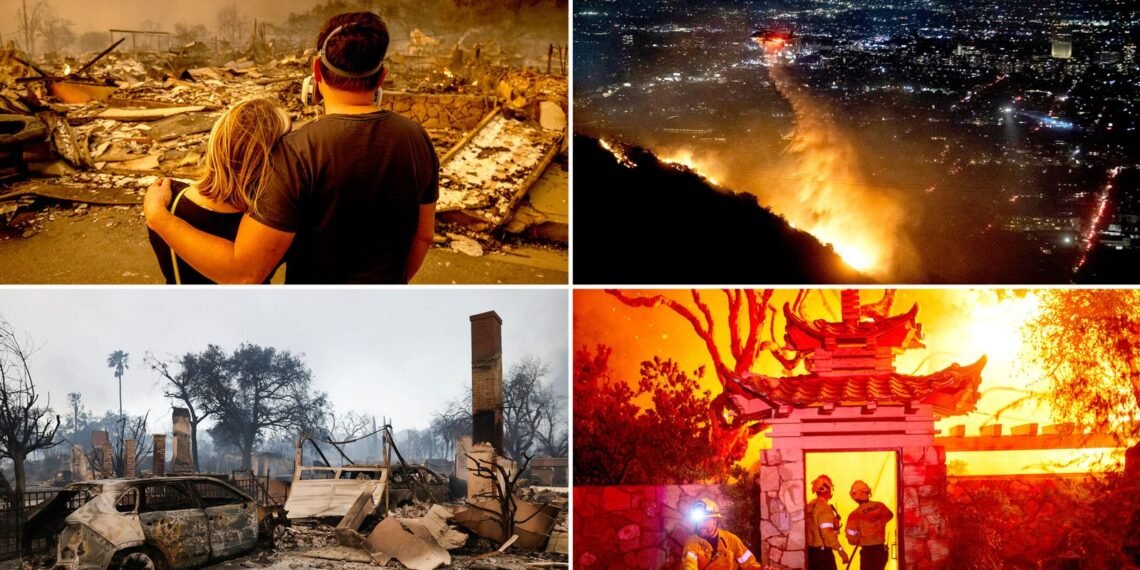California wildfires have left 16 dead, 13 missing, and over 180,000 displaced. More than 10,000 structures have been destroyed, with the Palisades and Eaton fires ranking among the state’s most destructive. Dry winds and resource strains are complicating firefighting efforts, with containment still out of reach.
BY PC bureau
The relentless Palisades Fire continues its destructive spread northeast, triggering new evacuations in Brentwood and Bel Air, two of Southern California’s wealthiest neighborhoods, according to a report by Bloomberg.
With dry winds expected to persist after a brief lull, the risk of further devastation remains high. Los Angeles County Supervisor Lindsey Horvath described the unfolding disaster as “another night of unimaginable terror and heartbreak.”
As per the report, the expanded evacuation zone now includes critical cultural landmarks, such as the Getty Center, an architectural masterpiece housing a world-renowned art collection. While the Getty Center was built with fire-resistant features, its resilience may soon be tested. Katherine Fleming, president and CEO of the J. Paul Getty Trust, assured that the art galleries are “safe and protected” and are under constant monitoring.
Nearby, the University of California, Los Angeles (UCLA) is on high alert, with officials advising preparations for possible evacuation. Parts of Bel Air east of the 405 freeway and Encino are also under evacuation warnings. This crisis recalls the 2019 Getty Fire, which forced high-profile residents, including LeBron James and former California Governor Arnold Schwarzenegger, to flee their homes.
⚡️🇺🇸JUST IN: Circulating footage shows fire tornadoes forming in LA during California wildfires. pic.twitter.com/psGNcVphb7
— Suppressed News. (@SuppressedNws) January 11, 2025
Death Toll and Displacement
As of Saturday night, the fires have claimed 16 lives—11 in Altadena from the Eaton Fire and five from the Palisades Fire. Thirteen individuals remain missing, while law enforcement has arrested 22 people for offenses including curfew violations, burglary, and looting. More than 180,000 residents have been forced to evacuate, with over 16,000 seeking assistance from the Federal Emergency Management Agency (FEMA).
Ferocity and Response
The Palisades and Eaton fires have destroyed thousands of homes and more than 10,000 structures, making them the third- and fourth-most destructive wildfires in California history. Combined, they have consumed nearly 37,000 acres, with containment levels at 11% for the Palisades Fire and 15% for the Eaton Fire. The Hurst Fire near San Fernando, which is 76% contained, also continues to burn.
Governor Gavin Newsom has doubled National Guard personnel deployed to 1,680 responders, bringing the total firefighting force to over 14,000. States like Oregon, Washington, Nevada, and Arizona have contributed additional resources. Nancy Ward, director of the Governor’s Office of Emergency Services, emphasized that the state is mobilizing “the whole of the government” to combat the fires, especially with severe weather anticipated early next week.
Federal and Utility Scrutiny
The fires have reignited debates about federal and local responses. While California officials have invited President-elect Donald Trump to tour the damage, he has not publicly responded. In his first term, Trump issued disaster declarations for wildfires but frequently criticized California’s fire management.
Utility companies are also under investigation. Southern California Edison is being scrutinized for its potential role in igniting the smaller Hurst Fire, while attorneys have asked the company to preserve evidence related to the Eaton Fire. Edison has reported 50,000 customers without power as a result of preemptive outages to mitigate fire risk.
❤️🩹 When you sometimes give up on humanity and then see this.
A man saving a bunny during the wildfire in LA.
God bless his heart. pic.twitter.com/LNijoHIv8o
— Mary (@MaryHogins) January 9, 2025
Budget Cuts and Resource Strains
The disaster has revealed tensions within Los Angeles’ firefighting infrastructure. City Fire Chief Kristin Crowley criticized budget cuts for hampering her department’s ability to respond effectively. Mayor Karen Bass defended the reductions, citing “tough budgetary times,” but emphasized the need to focus on immediate crisis management. Meanwhile, Governor Newsom has demanded an investigation into why hydrants in fire zones ran dry, pointing to a closed reservoir as a contributing factor.
Outlook
Dry winds and gusts up to 60 mph are expected through midweek, exacerbating fire risks in Los Angeles County. AccuWeather estimates the total economic losses from the fires could range between $135 billion and $150 billion, making this one of the most costly natural disasters in U.S. history.
Officials and communities alike are bracing for the days ahead, as the Palisades and Eaton fires continue their relentless path of destruction.












